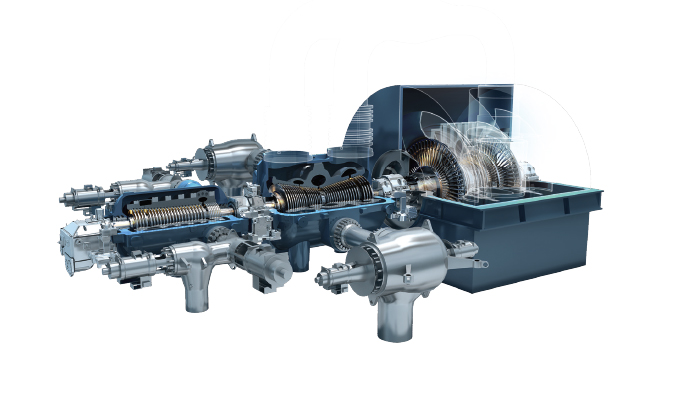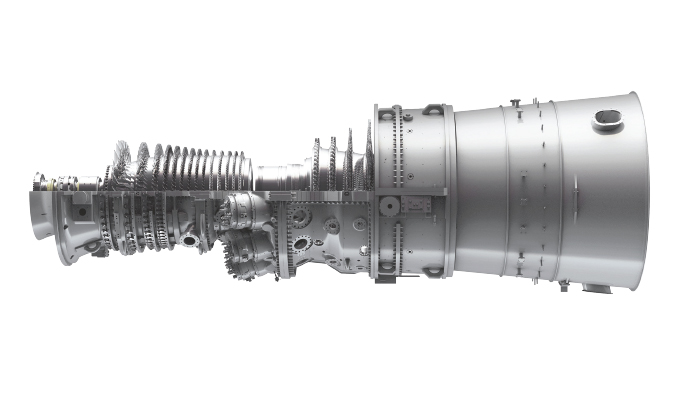GE recently began commercial operation for GS Power’s Anyang Combined Heat and Power (CHP) Plant Unit 2-2 in Anyang City, Gyeonggi Province, South Korea. The project consists of the renewal of older gas-powered assets with the latest turbine technology including one GE 7HA.02 gas turbine, with a matching GT H65 generator, one STF D650 steam turbine and a ST A39 generator, along with a Mark VIe Distributed Control System (DCS) software solution and services to support the availability and reliability of the plant. The updated plant now delivers approximately 500 megawatts (MW) of electricity, the equivalent output needed to power approximately 500,000 South Korean homes, while also providing steam for district heating for more than 180,000 citizens of Anyang City. Amidst the COVID-19 pandemic and extraordinary heavy rains and typhoons, the commissioning work was executed safely to ensure the plant achieved commercial operations one week ahead of schedule.
MORE ENERGY WITH FEWER EMISSIONS
The Anyang District Heating Plant benefits from GE’s HA technology, which is capable of reaching close to 62.2 percent net plant efficiency in combined cycle and more than 93 percent efficiency in district heating mode. District heating mode is enabled by industry leading steam turbine flexibility, allowing for high efficiency in both district heating and power only modes. This process captures and reuses excess heat or steam that would otherwise be released into the environment or go unutilized, effectively generating more energy and less carbon emissions per unit of fuel.
“Following GE’s successful modernization of Anyang CHP Unit 2-1, we chose to continue to partner with GE for the success of the second unit renewal project to support our efforts in delivering cleaner and more efficient combined heat and power to homes and businesses in the Anyang region,” says GS Power. “We trust in GE’s technology to help us in meeting the energy and heating needs of our communities in Anyang City, while reducing our plant’s carbon footprint. This project is also contributing towards the country’s goal laid out in the government’s Green New Deal to achieve carbon neutrality by 2050.”

ANOTHER STEP TOWARD A RENEWABLE FUTURE
Through the modernization of the Anyang combined heat plant, the plant is set to achieve more than 13.8 percent points of additional efficiency for electricity generation. Similar to the Naepo and Kospo district heating projects, Anyang CHP plant will connect to Korea’s Direct Heating System (DHS), a centralized system that distributes heat to residential developments since the 1990s. With a growing population of nearly fifty-two million, DHS delivers energy efficiency on a national level and has enabled better urban planning. The use of district-wide direct heating and cooling systems has helped South Korea contain carbon emissions, relative to the impact of individual heating and air-conditioning systems in line with the expansion of densely populated communities.
“Gas power plays a critical role in facilitating South Korea’s transition to a more energy efficient, reliable, and lower carbon future” says Ramesh Singaram, president and CEO of GE Gas Power Asia. “Since Korea’s long-term goal is to increase its reliance on renewable power sources, gas turbine technology is crucial to ensure the needed power to balance the variable nature of renewables and ensure system reliability at all times. We’re proud to work with GS Power to support South Korea’s district heating needs with a highly efficient energy solution that delivers energy savings and reductions in emissions.”

ONE PIECE OF A LARGER PUZZLE
GE is a major player in power generation in South Korea. GE’s gas turbines (simple and combined cycle) have the capacity to generate more than 14,000 megawatts of electricity with an installed base of over seventy-seven units. GE has been present in South Korea since 1976, working closely with local partners to support the country’s growth in energy, advanced infrastructure, and healthcare. In 2015, GE undertook a large-scale manufacturing plant investment in Changwon, South Korea, by acquiring Doosan’s HRSG business.
GE’s experience and proven technology in district heating applications in Korea includes not only GS Power’s combined-cycle power plant Unit 2-1 in Anyang, but also Naepo’s CHP plant in Naepo City Korea Southern Power Co., Ltd. (KOSPO)’s Shinsejong CHP plant at Sejong City, and Oseong CHP plant, in Pyeongtaek.
The project addressed unprecedented challenges during the construction phase. As COVID-19 pandemic infection rates climbed rapidly in the country, restrictions on travel reduced the availability and mobilization of resources. Transportation of power generation equipment was also challenged by extraordinary heavy rains during the typhoon season. Although this posed a significant challenge in bringing the plant in operation, the plant achieved commercial operation one week ahead of schedule through the use of a modular-based construction process—where large parts of the plant were manufactured and shipped already assembled to the construction site and the successful collaboration with GS Power and FieldCore, GE’s field services company.
FOR MORE INFORMATION
GE Gas Power is a world leader in natural gas power technology, services, and solutions. Through relentless innovation and continuous cooperation with our customers, the company is providing more advanced, cleaner, and efficient power that people depend on today and building the energy technologies of the future. With the world’s largest installed base of gas turbines and more than 670 million operating hours across GE’s installed fleet, GE Gas Power offers advanced technology and a level of experience that’s unmatched in the industry to build, operate, and maintain leading gas power plants. For more information, visit www.ge.com/power/gas.
MODERN PUMPING TODAY, May 2022
Did you enjoy this article?
Subscribe to the FREE Digital Edition of Modern Pumping Today Magazine!


